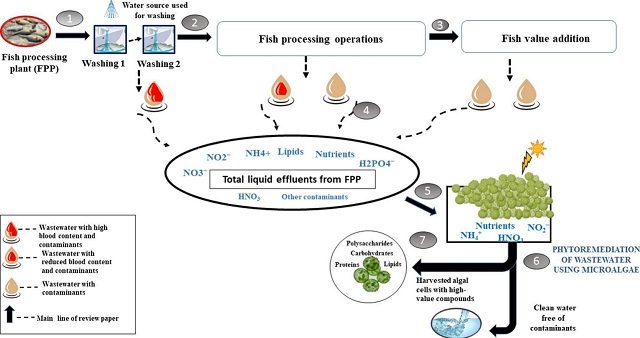
The discharge of highly concentrated wastewater from fish processing industries has sparked global concerns due to its complex mix of toxic and organic compounds.
Despite numerous known effluent treatment methods, recent attention has shifted to biosorption using naturally cultivated microalgae. The liquid effluents from the fish processing industry consist of organic matter, macro, and micronutrients crucial for the growth of microalgae.
A scientific review published by a team of researchers from Teagasc Food Research Centre, Munster Technological University, University College Cork, and the National Institute of Technology Rourkela explored the promising results of utilizing microalgae to eliminate organic contaminants from liquid effluents in the fishing industry. The focus was on transforming the collected microalgal biomass into valuable compounds.
The Promise of Microalgae
Recent studies have emphasized the potential of microalgae in efficiently removing organic contaminants from liquid effluents in fish processing. Despite numerous known effluent treatment methods, biosorption with naturally cultivated microalgae has recently emerged as a promising approach for eliminating organic compounds from liquid effluents.
“Interestingly, it was identified that the microalgal biomass collected from phytoremediation of fish processing effluents is rich in biocompounds,” noted the scientists.
This approach not only addresses environmental concerns but also harnesses the rich biocompounds found in microalgal biomass, creating opportunities for applications in pharmaceuticals, nutraceuticals, and aquaculture feed.
The integration of microalgae into phytoremediation showcases the potential of a circular bio-economy, where waste is transformed into valuable resources.
Potential of Fish Processing Wastewater for Microalgae Cultivation
The study analyzed the techno-economic feasibility of purifying effluents from fish processing industries using microalgal biomass, creating successive value-added constituents. The authors also reviewed cellular mechanisms for microalgae phytoremediation when cultivated from wastewater effluents of fish processing plants. They further examined key pathways to transform organic matter from fish processing effluents into value-added bioactive compounds derived from collected microalgal biomass.
Stay Always Informed
Join our communities to instantly receive the most important news, reports, and analysis from the aquaculture industry.
Pharmaceuticals, Nutraceuticals, and Feed Applications
The microalgal biomass derived from phytoremediation of liquid effluents from the fish processing industry proves to be a valuable source of biocompounds. These compounds exhibit significant potential in the pharmaceutical and nutraceutical industries, offering sustainable alternatives.
Moreover, the biomass can be utilized in aquaculture feed, establishing a closed-loop system that contributes to the circular economy while addressing challenges associated with wastewater from food processing industries.
Microalgae Species and Efficiency
Among the evaluated microalgae species for the absorption and removal efficiency of nutrients from fish effluents, Chlorella sp., Spirulina sp., and Scenedesmus sp. emerged as the most promising. Understanding the characteristics of these species is crucial for optimizing their use in phytoremediation processes.
Supercritical Fluid Extraction
Researchers cite that, to extract key biological components, namely polysaccharides, lipids, proteins, and carbohydrates from the collected microalgal biomass, primary extraction technologies include microwave-assisted extraction, ultrasound-assisted extractions, pulsed electric field-assisted extraction, enzyme-assisted extraction, and cold plasma-assisted extraction, among others.
However, the scientific review identifies supercritical fluid extraction as a robust tool for extracting specific bioproducts from microalgal biomass cultivated in fish effluents. This extraction method enhances efficiency in obtaining valuable compounds, further emphasizing the economic viability of microalgae-based phytoremediation.
Conclusion
This review underscores the potential of microalgae species as natural, cost-effective adsorbents for the removal of organic contaminants from fish liquid effluents. By exploring the mechanisms through which microalgae absorb and convert organic matter, the article provides valuable information for researchers, environmentalists, and industries.
“Based on the scientific works discussed in this review, it can be demonstrated that microalgae are sustainable candidates for the efficient treatment of wastewater discharged from fish processing plants and other food processing industries,” conclude the study authors.
The presented information establishes phytoremediation using microalgal biomass as a natural, cost-effective, and sustainable circular bio-economy approach for efficiently treating wastewater discharged by food processing industries.
Adopting this approach not only addresses environmental concerns but also opens pathways for the development of valuable bioproducts, contributing to a more sustainable and circular future for the fish processing industry.
The study was funded by the European Union through the EnhanceMicroAlgae project under the Interreg Atlantic Area Project.
Contact
Gaurav Rajauria
Department of Biological and Pharmaceutical Sciences, Munster Technological University,
Tralee V92 CX88, Co. Kerry, Ireland.
gaurav.rajauria@mtu.ie
grajauria@ucc.ie
Brijesh K. Tiwari
Teagasc Food Research Centre, Department of Food Chemistry and Technology, Ashtown D15 KN3K, Dublin, Ireland
brijesh.tiwari@teagasc.ie
Reference
E.J. Rifna, Gaurav Rajauria, Madhuresh Dwivedi, Brijesh K. Tiwari. 2024. Circular economy approaches for the production of high-value polysaccharides from microalgal biomass grown on industrial fish processing wastewater: A review, International Journal of Biological Macromolecules, Volume 254, Part 3, 2024, 126887, ISSN 0141-8130, https://doi.org/10.1016/j.ijbiomac.2023.126887.
Editor at the digital magazine AquaHoy. He holds a degree in Aquaculture Biology from the National University of Santa (UNS) and a Master’s degree in Science and Innovation Management from the Polytechnic University of Valencia, with postgraduate diplomas in Business Innovation and Innovation Management. He possesses extensive experience in the aquaculture and fisheries sector, having led the Fisheries Innovation Unit of the National Program for Innovation in Fisheries and Aquaculture (PNIPA). He has served as a senior consultant in technology watch, an innovation project formulator and advisor, and a lecturer at UNS. He is a member of the Peruvian College of Biologists and was recognized by the World Aquaculture Society (WAS) in 2016 for his contribution to aquaculture.




